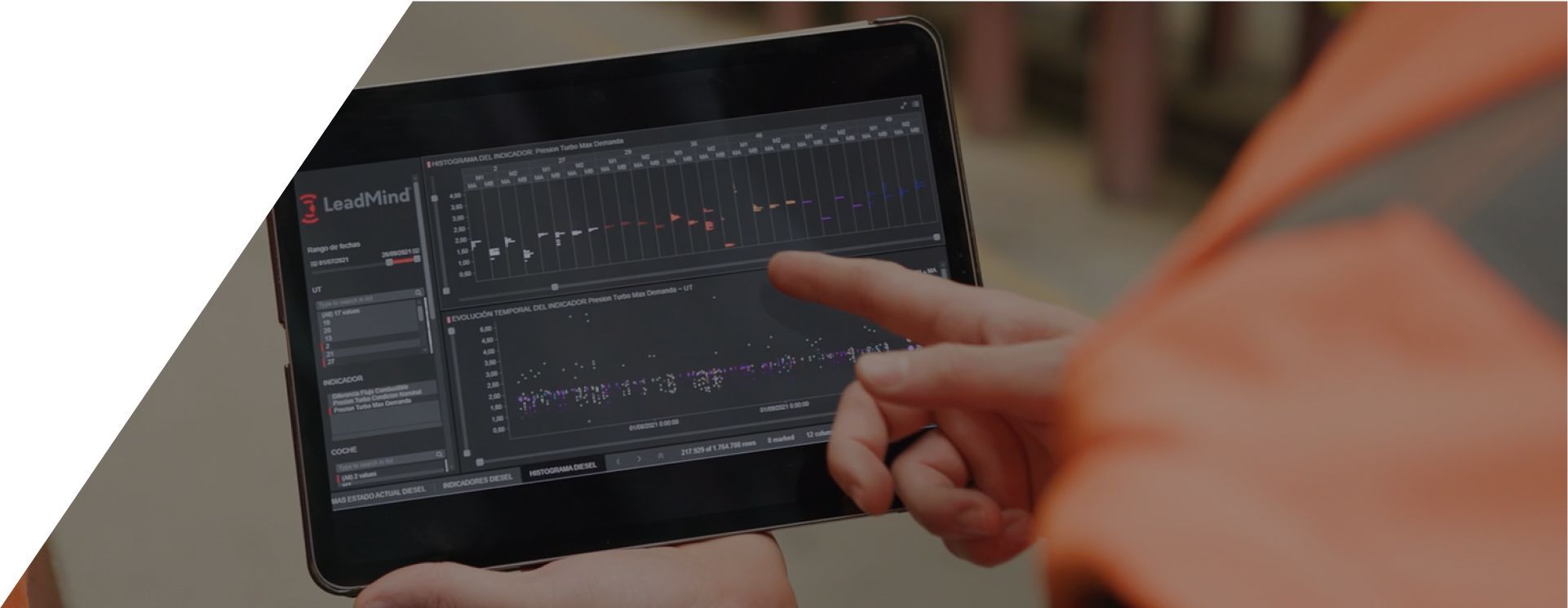The technology behind the CBM: How to optimize predictive train maintenance
Predict failures before they occur: CBM's key steps to preventive and predictive train maintenance. CBM makes possible to repair potential failures before the train component fails or performance falls below the optimal level.
Defining, deploying optimizing and properly validating CBM (Condition-Based Maintenance) indicators through LeadMind is key to evolve from kilometre-based maintenance to a condition-based and a later predictive plan. These indicators help to anticipate failures and solve them before the unit becomes inactive. With the sensors installed on the train and through advanced analytics, we are able to predict whether any train component is showing signs of diminishing performance or symptoms of a more immediate failure.
+imagen
For each indicator, an optimal performance range is defined, either by simple measurement, statistical analysis, or an artificial intelligence model. If the calculated indicator is outside the set range, an automatic alarm is generated, warning the maintainer which part of the train should be checked and/or repaired.
Our LeadMind advanced analytics solution enables maintenance depot to detect on-board equipment failures early, reducing fleet unit downtime and greatly optimizing train maintenance tasks.
In this video you can discover the success story of CBM with Actren, a railway maintenance company.
+imagen
How are the indicators to be considered in the CBM defined? Optimaly analyze, adjust and define failure thresholds
The process we carry out at CAF to define these indicators begins with the identification of a business need in 3 specific lines. For all of them, we have a range of indicators for different types of vehicles and operating conditions as a result of the gained experience in more than 20 projects, in different countries and conditions.
- Detect a specific failure mode, which we can either suggest from our LeadMind department or through an analysis with the workshop team, with whom we maintain very fluid and regular communication and coordination.
- Automate short-cycle preventive maintenance tasks.
- Improve preventive maintenance frequencies in long cycle where more material can be saved.
Afterwards, we analysed the team's behaviour and evaluated the variables available on the train to see which are related to failure mode, which can be used and what conclusions we can draw. Based on these references, the values are first programmed, and the results are validated by comparing them with the available data.
It is in this part of the process that the knowledge and experience of CAF on railway industry is valued. We analyse, adjust, and define the failure thresholds, combining a comprehensive analysis of the data with our technical knowledge on the operation of the equipment. We are able to adjust the range where alerts are generated to get the least number of false positives.
The importante of data quality and reliability for and optimal predictivde train maintenance
For an indicator to be efficient and effective, it is essential to guarantee a daily frequency in the reception of the data. Therefore, the data collected by our CBM department is updated during the day and at night. The processes that generate the visualized alarms are executed so that the workshop can have information about the state of the fleet the following day.
In addition, we conduct a periodic and monitored review of the condition of each of the train components, providing train maintainers information on the status of the fleet, the proper functioning of the equipment, possible defects, and life cycles of the components.
We managed to ensure that the indicators do not contain any kind of error and are properly configured. To do so, from CAF Digital Services we ask for a number of basic requirements:
- Data quality and reliability: if the installed sensors fail, or the data collection and reception process have a defect, the indicator will not be well optimized or directly will not be useful.
- Regularity of data: if there is no daily frequency in the receipt of data, by the time the fault is detected it may be that there has already been a failure in another system or, in the worst case, that the repair has been forced.
- Collaboration of the workshops: it is essential to establish direct and continuous feedback with the maintainers in order to validate the indicators, both at the level of functioning and useful for the workshop itself.
How are indicators integrated into the fleet management and monitoring system?
Depending on the level of maturity of the indicator, there are different degrees of integration. When it is at first level, the data is incorporated into the rail fleet management and monitoring system by means of a display showing all the indicators classified by system (air conditioning, temperature, oil, etc.). And every unit, which allows you to identify which trains are failing and where.
If the indicators are validated by workshop staff, they can be directly integrated with the railway maintenance software of the workshop itself and generate orders to work on the exact fault and its associated repair tasks.
The indicators offer several advantages when it comes to CBM maintenance of trains:
- Optimize end-of-cycle replacement maintenance (overhaul): Normally life indicators are defined in kilometres or hours of train running, while CBM indicators point to a more accurate value allowing the replacement of equipment to be extended at the time when the limit is reached.
- Extend fleet life: in the event of a failure, it will be detected before it threatens the availability of the train.
- Maintenance tasks are greatly optimized: by monitoring failures in the fleet, workshops can directly repair defective equipment.
Indicators used in the CBM provide maintenance workshops with a data history for planning and optimizing railway maintenance, detecting, and repairing potential failures before they become a problem and may affect fleet operation and availability.
Article written by Alejandro Garcia, CBM Engineer at CAF Digital Services


 .
.